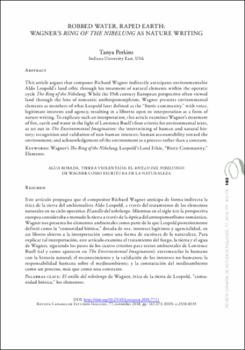Robbed Water, Raped Earth: Wagner’s Ring of the Nibelung as Nature Writing
Author
Perkins, TanyaDate
2018Abstract
Este artículo propugna que el compositor Richard Wagner anticipa de forma indirecta la
ética de la tierra del ambientalista Aldo Leopold, a través del tratamiento de los elementos
naturales en su ciclo operático El anillo del nibelungo. Mientras en el siglo xix la perspectiva
europea consideraba a menudo la tierra a través de la óptica del antropomorfismo romántico,
Wagner nos presenta los elementos ambientales como parte de lo que Leopold posteriormente
definió como la “comunidad biótica,” dotada de voz, intereses legítimos y agencialidad, en
un libreto abierto a la interpretación como una forma de escritura de la naturaleza. Para
explicar tal interpretación, este artículo examina el tratamiento del fuego, la tierra y el agua
de Wagner, siguiendo los pasos de los cuatro criterios para textos ambientales de Lawrence
Buell (tal y como aparecen en The Environmental Imagination): entremezclar lo humano
con la historia natural; el reconocimiento y la validación de los intereses no-humanos; la
responsabilidad humana sobre el medioambiente; y la constatación del medioambiente
como un proceso, más que como una constante. This article argues that composer Richard Wagner indirectly anticipates environmentalist
Aldo Leopold’s land ethic through his treatment of natural elements within the operatic
cycle The Ring of the Nibelung. While the 19th century European perspective often viewed
land through the lens of romantic anthropomorphism, Wagner presents environmental
elements as members of what Leopold later defined as the “biotic community,” with voice,
legitimate interests and agency, resulting in a libretto open to interpretation as a form of
nature writing. To explicate such an interpretation, this article examines Wagner’s treatment
of fire, earth and water in the light of Lawrence Buell’s four criteria for environmental texts,
as set out in The Environmental Imagination: the intertwining of human and natural history;
recognition and validation of non-human interests; human accountability toward the
environment; and acknowledgement of the environment as a process rather than a constant.





